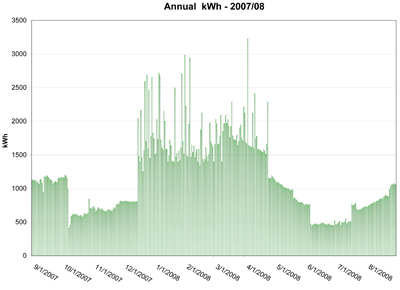
Features
Energy
Management
Special Series energy matters: Working to become an effective energy leader
May 4, 2009 By Chris Hanlon
The last time we addressed energy management, we looked at getting started, appointing an energy champion, and balancing between the do-it-yourself approach and using experts.

|
The last time we addressed energy management, we looked at getting started, appointing an energy champion, and balancing between the do-it-yourself approach and using experts.
This month, we will focus on the first steps required to become an energy leader and why it is important to think strategically long term.
You have made the decision to become more energy efficient. Where do you start and what do you do? Often, companies install alternate or renewable energy generation systems to offset their energy use prior to undertaking efficiency initiatives. This can be a costly mistake because this approach can lead to over-estimating your needs. Implementing a system that is larger than you need requires more capital, is more costly to operate, can significantly change your payback period, and may lead to a stranded asset where you walk away from your investment out of frustration.
DEVELOPING A THOROUGH AND STRAIGHTFORWARD PLAN
Ensuring success begins with a thorough and straightforward plan that includes:
| • | Determining where you are today and what your historical usage levels and patterns have been. Examine all your different sources of energy use. If water use is significant, either volumetrically or as a cost, look at water use as well. |
Many owners believe they know exactly how they use their energy and many are surprised with the results an in-depth analysis can uncover. The number of people involved in running your operation and changes over time will have an impact on energy use. When you look at your consumption in graphical form, what you expect to find is often different from reality.
Benchmarking to measure changes in usage levels and patterns. Marking your starting point will help you track improvements as a result of your efficiency methods. Also, it is important when we look at carbon management – a later column.
| • | Setting goals for reduction. Goals are required to achieve success, but must be attainable. They need to include how much you expect to spend, over what period of time, and what you expect to achieve in return for your efforts. The key here is balance! Remember, goals are flexible and allow easy management and manipulation as you progress through your plan. |
| • | Involvement of your Energy Champion and staff. Regardless of the size of your organization, engaging your staff will help ensure the success of your efficiency projects. Have some fun with this. Organize a contest for staff to contribute their ideas for energy savings. Reward and recognize good suggestions or responsible energy use behaviour. |
| • | Identification of your energy savings projects. Projects can be process-based, where changes are made operationally or in how you conduct business, or maintenance-based, where you take care of equipment and complete any repairs needed. |
SOME CHANGES CAN BE FREE OR AT LEAST LOW COST
Process-based projects can include simple steps like turning off equipment or appliances when they are not in use. These changes are great because they are generally free or low cost. They can be found through a careful examination and re-evaluation of regular day-to-day tasks that will undoubtedly reveal things that can be performed during off-peak hours, performed in a different manner, or sometimes eliminated altogether without affecting the final product.
Maintenance-based projects can include repairing leaks or making sure equipment is running at peak performance. They can also include complete changes or upgrades in equipment or facilities.
Identification of your energy savings projects can be achieved through a formal analysis of your energy use, or through a full audit. Depending on your operation, you may need assistance to accomplish this important step as it is one of the best ways to pinpoint projects that will give you the biggest bang for your buck.
| • | Setting priorities from the possible projects outlined through your energy analysis and audit. Included in your list of possible projects should be approximate costs, payback periods and potential rebates or incentives that can help to create your energy improvement budget. Hint: Some rebates can only be applied for annually, so if you have more than one project scheduled, even if they occur at different times of the year, make sure you include all of them in your submission. |
KEEP TRACK OF OUTPUT LEVELS AND PLANT QUALITY
Keep in mind that selected projects should improve or maintain the production levels of your crop and plants. Make sure to keep track of your plant output levels and plant quality.
If your Energy Plan includes the above points, you ensure that your roadmap to energy efficiency is ready for success.
Next month, we will talk about implementing your plan and how to complete your projects efficiently for efficiency.
Print this page